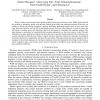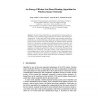ATAL
2006
Springer
14 years 4 months ago
2006
Springer
Today's wireless sensor networks have limited flexibility because their software is static. Mobile agents alleviate this problem by introducing mobile code and state. Mobile ...
APNOMS
2006
Springer
14 years 4 months ago
2006
Springer
Abstract. A wireless sensor network is a collection of devices limited in lowpowered batteries, processing, communication bandwidth capabilities and low memory availability. Due to...
ANTSW
2006
Springer
14 years 4 months ago
2006
Springer
Abstract. Wireless Sensor Networks are characterized by having specific requirements such as limited energy availability, low memory and reduced processing power. On the other hand...
GLOBECOM
2007
IEEE
14 years 4 months ago
2007
IEEE
Wireless sensor networks have been widely used in many surveillance applications. Due to the importance of sensor nodes in such applications, certain level of protection needs to b...
EMNETS
2007
14 years 4 months ago
2007
Currently, there is a lack of stand-alone geo-monitoring systems for harsh environments that are easy to configure, deploy and manage, while at the same time adhering to science g...
EMNETS
2007
14 years 4 months ago
2007
The node localization problem in Wireless Sensor Networks has received considerable attention, driven by the need to obtain a higher location accuracy without incurring a large, p...
EMNETS
2007
14 years 4 months ago
2007
Deployment of a wireless sensor network (WSN) system is a critical step because theoretical models and assumptions often differ from real environmental characteristics and perform...
CNSR
2007
IEEE
14 years 4 months ago
2007
IEEE
This paper presents a data routing protocol for a non-mobile, locationaware wireless sensor network that is primarily designed for continuous monitoring application (e.g. environm...
AINA
2007
IEEE
14 years 4 months ago
2007
IEEE
Abstract--Monitoring and automatic control of building environment is a crucial application of Wireless Sensor Network (WSN) in which maximizing network lifetime is a key challenge...
DCOSS
2009
Springer
14 years 5 months ago
2009
Springer
Radio Frequency (RF) tomography refers to the process of inferring information about an environment by capturing and analyzing RF signals transmitted between nodes in a wireless se...




